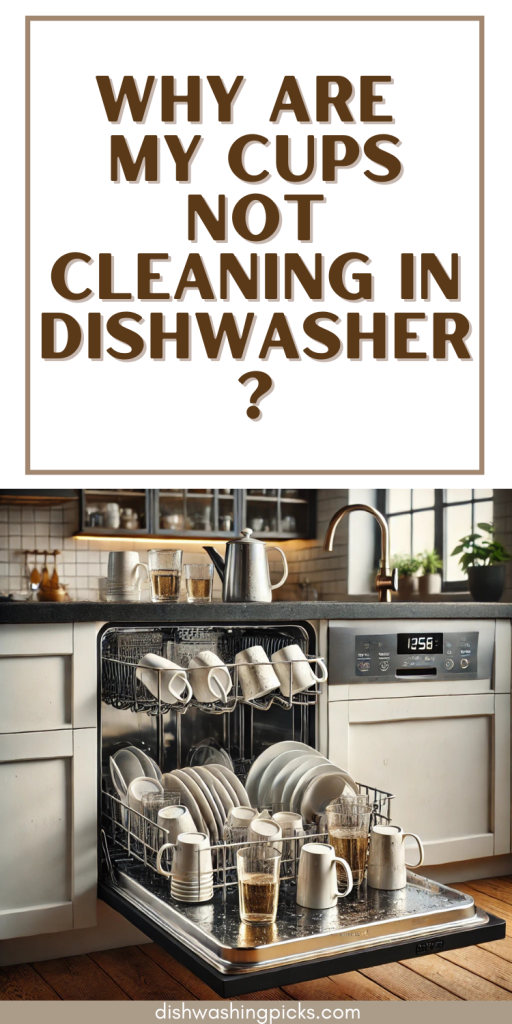
Ever opened your dishwasher, expecting sparkling clean cups, only to find them still covered in grime, water spots, or—worst of all—mysterious food residue? Yeah, it’s frustrating. You bought a dishwasher to do the hard work for you, not to leave you scrubbing cups by hand. So what’s going wrong? Let’s break it down.
1. Are You Loading the Dishwasher Correctly?
It might sound basic, but trust me, improper loading is one of the top culprits.
- Cups too close together? If cups are jammed in too tightly, water and detergent can’t circulate properly. Give them some breathing room.
- Upside-down and at an angle? Always place cups upside-down but slightly tilted to avoid pooling water.
- Blocking the spray arms? If your cups (or any dishes) are positioned in a way that obstructs the spray arms, water won’t reach them properly. Spin the arms before starting the wash to ensure they move freely.
Try This: Next time you load your dishwasher, pretend you’re a jet of water. Would you be able to reach every surface of your cups? If not, rearrange!
2. Check Your Dishwasher’s Filter
Did you even know your dishwasher has a filter? (A lot of people don’t.) Over time, food particles and grease can clog it, reducing water flow and leaving your dishes grimy.
- Find it: Typically located at the bottom of the dishwasher.
- Clean it: Remove it and rinse under warm water. If it’s gunky, scrub it with an old toothbrush and some mild detergent.
- Frequency: Ideally, clean your filter every month, or more often if you use your dishwasher daily.
Bonus Tip: If you notice a bad smell coming from your dishwasher, the filter is probably the culprit.
3. Hard Water Woes
If you live in an area with hard water, mineral deposits can build up on your dishes, leaving them looking cloudy or spotty.
- Solution: Try adding a rinse aid to prevent water spots and keep cups looking crystal clear.
- DIY Fix: White vinegar is a great natural solution—just add a cup to the bottom of your dishwasher before running a cycle.
- Long-Term Option: Consider installing a water softener if hard water is a persistent issue in your home.
4. Detergent Matters More Than You Think
Not all detergents are created equal. If you’re using a bargain-brand detergent, it might not be cutting through grease and grime effectively.
- Use high-quality detergent pods or tablets—they tend to dissolve better and distribute more evenly.
- Don’t use too much detergent. It might seem like more soap equals cleaner dishes, but excess detergent can leave a film on your cups.
- Store detergent properly. Moisture can cause detergent powder to clump up, making it less effective. Keep it in a cool, dry place.
5. Water Temperature: Hot Enough?
Dishwashers rely on hot water to break down grease and kill bacteria. If your water isn’t hot enough, your cups might not come out as clean as they should.
- Test your water temperature: Run your kitchen tap on hot and use a thermometer to check—it should be at least 120°F (49°C).
- Run the hot water before starting your dishwasher to ensure it starts with the hottest possible water.
6. Is Your Dishwasher Itself Dirty?
Yes, the machine that cleans your dishes also needs cleaning. If your dishwasher is full of grease, mold, or food debris, it won’t do a great job cleaning your cups.
- Deep clean once a month: Run an empty cycle with a cup of white vinegar on the top rack to break down buildup.
- Check spray arms for clogs: Use a toothpick to remove any food bits stuck in the holes.
- Wipe down seals and gaskets to prevent mold growth and bad odors.
Final Thoughts
If your cups aren’t coming out clean, don’t worry—you’re not alone! With a few simple adjustments, you can get your dishwasher working like new again. Start with the basics: check your loading technique, clean the filter, and make sure your water temperature is high enough. Small tweaks can make a big difference!
Got other dishwasher woes? Let’s troubleshoot together—drop your questions in the comments!
